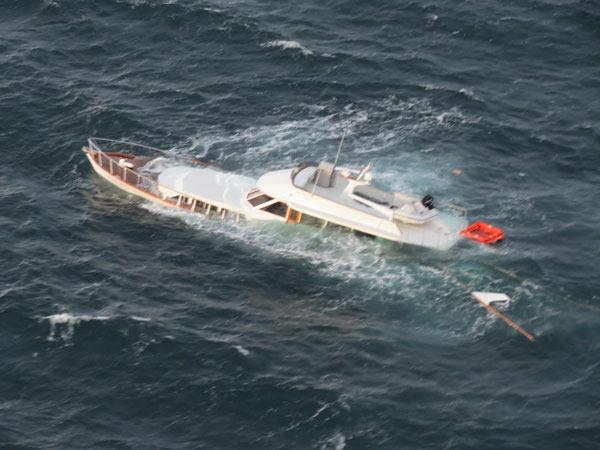Following a mayday signal at 7:31 a.m., Friday, Oct. 17, a 70-foot wooden yacht with 700 gallons of fuel went awash about a quarter mile off the Dungeness Spit in the Strait of Juan de Fuca.
Two people were on board the yacht, including the owner of Platypus Marine, Inc., and yacht owner/operator Judson Linnabary and a deck hand.
Officials with the U.S. Coast Guard rescued the two individuals aboard the Lady A successfully and without injury before it slipped beneath the water’s surface.
The wreckage
Despite the success of the rescue operation, the recovery of the Lady A proved a tougher challenge.
Even with air support from the U.S. Coast Guard and the use of a drift model, it took about 30 hours for the crew from Marine Assist of Port Hadlock to locate the Lady A. It wasn’t until Sunday evening that the majority of Lady A was towed into Port Angeles to the Platypus Marine, Inc. shipyard.
“It was so difficult primarily because of high winds and rough weather conditions,” Roger Slade, owner of Marine Assist of Port Hadlock, said. “It made it very difficult to spot.”
Once located, the Marine Assist crew pumped water from Lady A in order to re-float the yacht and towed it to John Wayne Marina during calm waters on Saturday prior to its final trip to Port Angeles.
Although the majority of Lady A, including the hull and living quarters were located within two miles of the location of the mayday signal, debris and a small skiff were recovered near Victoria, B.C., Slade said.
“Because the boat had 700 gallons of fuel onboard – risks of pollution became a major concern with recovery,” Slade said.
Once located, it was determined the yacht lost no fuel in the event and no fuel slicks were reported from the air.
“There is still a piece of the superstructure out there,” Slade said. “It’s much further east now.”
A portion of Lady A, including the pilot house, is still adrift in now the eastern side of the Strait of Juan de Fuca and the recovery of remaining debris is “really weather dependent,” Slade said. With the pollution concern at ease, the urgency to recover the remainder of Lady A is reduced.
As boaters voluntarily report the remaining wreckage to the U.S. Coast Guard, Coast Guard officials are passing the location and status of the debris onto Slade and his crew.
“It’s not a very large piece and we don’t expect it is going to be hazardous,” Petty Officer Katelyn Shearer with Coast Guard District 13 in Seattle, said.
A successful operation
“The two on board didn’t even get wet,” Slade said. “In all my years doing this, this was one of the most successful rescue operations.”
As a hub of larger commercial marine assistant agency, BoatU.S./Vessel Assist, Marine Assist of Port Hadlock services Port Townsend, Port Hadlock, the Hood Canal and the Strait of Juan de Fuca.
Within four minutes of receiving the mayday signal, Slade and his crew were on their way from Port Hadlock to the yacht in distress.
“I was already on my boat making coffee when I heard the mayday,” Slade said.
Within about 40 minutes of the urgent signal, U.S. Coast Guard officials had rescued the individuals preparing to abandon the yacht. A passing container vessel, the Tokyo Express, also sent a small boat with crew to aid in the rescue if need be, Slade said.
Through the continuous and clear communication and collaboration among the U.S. Coast Guard, officials at John Wayne Marina, Tokyo Express crew, Washington State Department of Ecology officials and the Marine Assist crew, Slade said the operation was “text book.” However, the only loss in the event will likely be the Lady A, which he anticipates will be declared a “constructive total loss.”
The official cause of how the Lady A became awash is yet to be determined, but damage to wooden ribs in its hull allowed for the onset of water. After reviewing the damage Slade suspects some type of “severe impact” would have had to occur for the yacht to take on water, like striking a log perhaps.
The Lady A was built in 1975, Marty Marchant, Platypus Marine director of sales, said.
“It’s important for people to realize that this was an old wooden yacht and maybe it was just old and tired,” Marchant said. “We see some indication that it could have been impacted, but it is all speculation at this point.”
Because the yacht was made of wood, Lady A never actually “sunk” but instead settled just a few feet below the water’s surface.
This recovery operation is one of about 15 recoveries Marine Assist of Port Hadlock has been involved with this year, Slade said.
Having sailed in many parts of the world, Slade admits the area between the Dungeness Spit and Deception Pass can be some of the most tricky waters to navigate primarily because it is a convergent zone.



